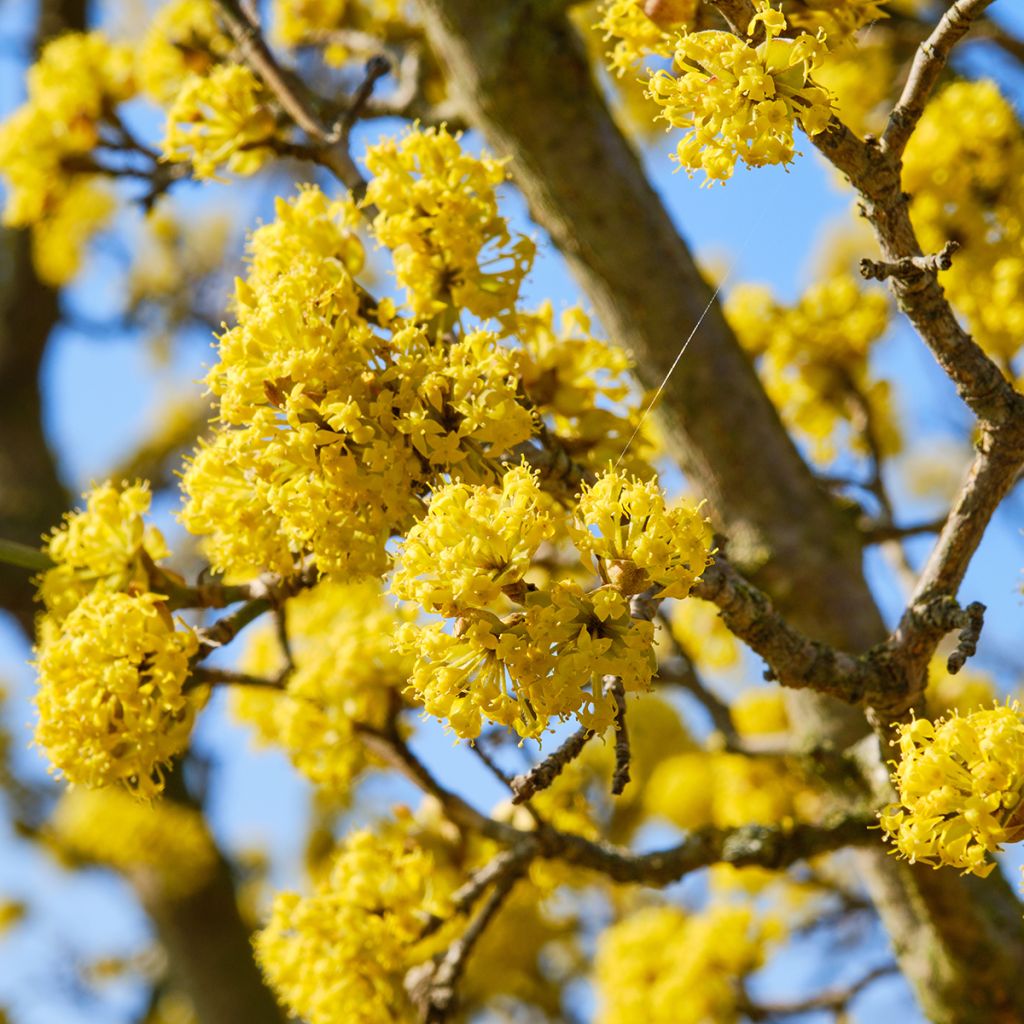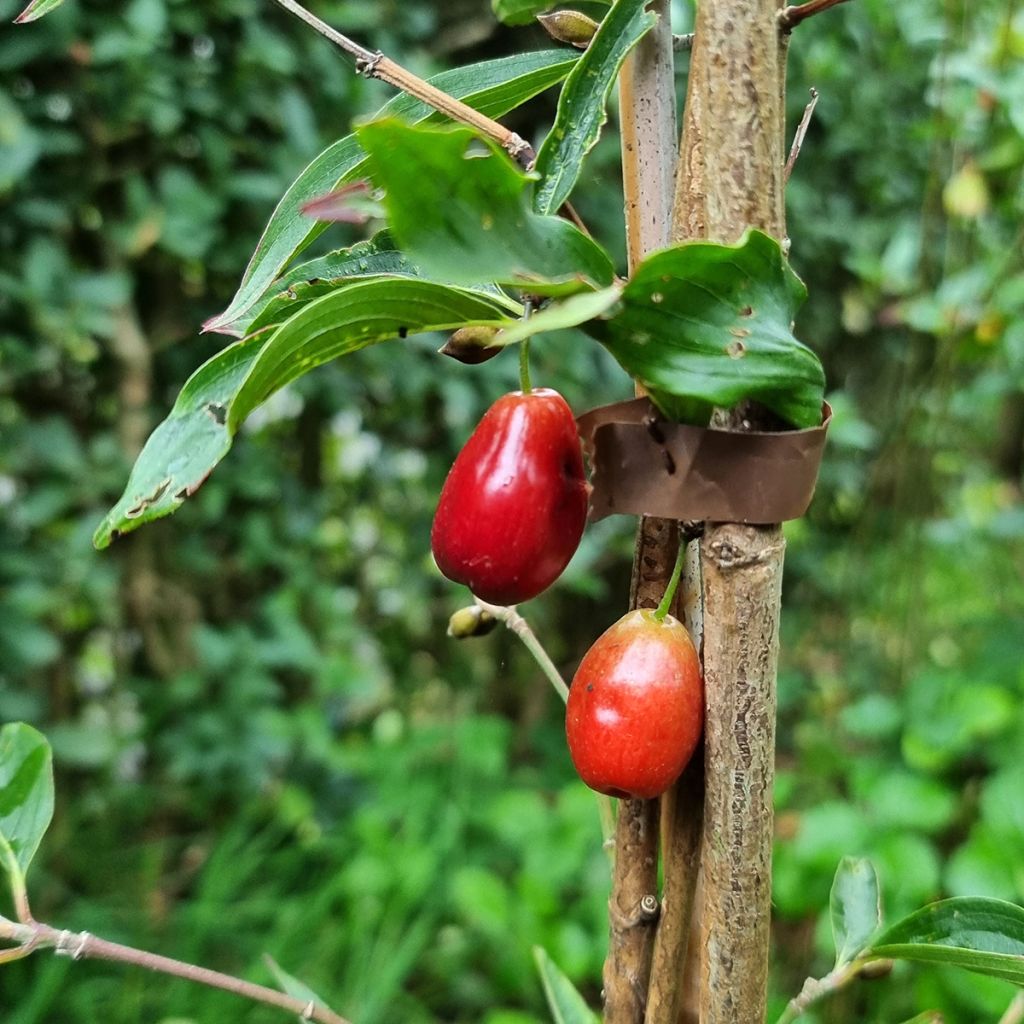

Cornus mas Kasanlak - European Cornel


Cornus mas Kasanlak - European Cornel
Cornus mas Kasanlak - European Cornel
Cornus mas Kasanlak
Cornelian Cherry, European Cornel
The Cornus arrived with many dry and curled leaves, with brown spots on the underside. I am very disappointed.
Dominique , 20/06/2025
Special offer!
Receive a €20 voucher for any order over €90 (excluding delivery costs, credit notes, and plastic-free options)!
1- Add your favorite plants to your cart.
2- Once you have reached €90, confirm your order (you can even choose the delivery date!).
3- As soon as your order is shipped, you will receive an email containing your voucher code, valid for 3 months (90 days).
Your voucher is unique and can only be used once, for any order with a minimum value of €20, excluding delivery costs.
Can be combined with other current offers, non-divisible and non-refundable.
Home or relay delivery (depending on size and destination)
Schedule delivery date,
and select date in basket
This plant carries a 24 months recovery warranty
More information
We guarantee the quality of our plants for a full growing cycle, and will replace at our expense any plant that fails to recover under normal climatic and planting conditions.

Would this plant suit my garden?
Set up your Plantfit profile →
Description
Cornus mas 'Kazanlak' forms a small tree or large bush offering yellow, dazzling flowers from March to April followed by large pear-shaped, crimson-red fruits from August. It is one of the first shrubs to bloom in spring and will be particularly enhanced by a carpet of spring bulbs such as muscari, daffodils, and early perennials like hellebores. Its large lemon-yellow flowers are also nectar-rich, making it a valuable source of nectar for bees during the winter months. The fruits are decorative due to their size and brilliant colour but are mainly cultivated for consumption. With a high content of vitamin C and minerals, they can be eaten raw or cooked in the form of jellies, jams, syrups, etc. The cornelian cherry is an easy-to-grow species that tolerates all well-drained soils, as long as it enjoys sunshine or partial shade. It is a sturdy and hardy tree or bush, suitable for planting in climates with warmer and drier summers and for gardens with chalky soils!
Cornelian cherries are native to southeastern and central Europe, where their late winter flowering is appreciated to brighten up public spaces and gardens still bare at this time of year. In February-March, their bare branches are covered with a multitude of small golden-yellow star-shaped flowers, gathered in clusters. They appear on the branches, in a colourful scene. The flowers, visited by the first bees of the season, give way to the appearance of edible berries, cornels, which ripen and turn red at the end of summer. Cornelian cherries are vigorous, compact shrubs with an upright habit when young, and spreading as they age. In our gardens, they reach about 5 metres (16 feet 5 inches) in height with a similar spread. They have dark green foliage, composed of elliptical leaves, 4 to 10 cm (1.6 to 3.9 in) long. In autumn, the Cornus mas catches the eye when it ignites with incandescent colours, predominantly deep red.
'Kazanlak' is a recent Bulgarian cultivar and is characterized by very large pear-shaped, crimson-red fruits measuring 3 to 5 cm (1.2 to 2 in). It reaches 4.5 meters (14 feet 10 inches) in all directions, making it suitable for embellishing a small garden or framing a terrace. Its fruits also distinguish it from the typical species as they are 2 to 3 times larger than regular cornels, weighing about 8 grams each. Very sweet and particularly rich in vitamin C, they are generally harvested from August. They can be enjoyed as jam, jelly, or just fallen from the tree, provided they are fully ripe. Birds gladly feed on them, contributing to maintaining a healthy ecosystem in your garden. The variety is self-fertile and can produce up to 150 kg of fruit after 40 years of cultivation. However, it is recommended to plant at least two specimens to ensure satisfactory fruiting.
The 'Kazanlak' Cornelian cherry likes sunny to semi-shady locations. It is very undemanding and it happy with ordinary, light, and poor, even chalky, soil. Plant it in a mixture of potting soil and garden soil that you have enriched with organic fertilizer. Avoid stagnant water in winter by planting it in well-drained soil. Its great hardiness allows it to withstand temperatures down to -20°C. Pruning of Cornus mas is not necessary but can be done at the end of winter, before the resumption of vegetation, to shape the shrub or remove dead or diseased wood. It is not very susceptible to diseases.
This small Cornelian cherry can be planted as a standalone specimen and become the highlight of a lawn from late winter when it is covered in flowers, in September with its multitude of red berries, and in autumn with its fiery foliage. It can also be used as a background plant in a border, accompanied by evergreen hedge shrubs such as Eleagnus ebbingei or Photinia fraseri 'Red Robin' to enhance its luminous flowering. This Cornus will also find a place in a hardy hedge, alongside an Arbutus or a burning bush, to attract wildlife to your garden with their decorative berries. Its modest size also allows it to be grown in a large container to decorate a terrace or balcony, along with evergreen shrubs that will take over when the Cornus goes dormant for winter.
Report an error about the product description
Cornus mas Kasanlak - European Cornel in pictures


Plant habit
Flowering
Foliage
Botanical data
Cornus
mas
Kasanlak
Cornaceae
Cornelian Cherry, European Cornel
Cultivar or hybrid
Planting and care
The 'Kazanlak' Cornelian cherry bush likes sunny to semi-shaded situations. It is not very demanding and can thrive in ordinary, light, and poor soil, even limestone. Plant it in a mix of horticultural compost and garden soil that you have enriched with organic fertilizer. Make sure to avoid stagnant water in winter, by planting it in well-drained soil. Its great hardiness allows it to withstand temperatures as low as -20°C (-4 °F).
Pruning of the Cornus mas is not necessary, but can be done at the end of winter to shape the bush or remove dead or diseased wood. It is not very susceptible to diseases and proves to be a very pleasant subject to grow.
Planting period
Intended location
Care
-
, onOrder confirmed
Reply from on Promesse de fleurs
Similar products
Haven't found what you were looking for?
Hardiness is the lowest winter temperature a plant can endure without suffering serious damage or even dying. However, hardiness is affected by location (a sheltered area, such as a patio), protection (winter cover) and soil type (hardiness is improved by well-drained soil).

Photo Sharing Terms & Conditions
In order to encourage gardeners to interact and share their experiences, Promesse de fleurs offers various media enabling content to be uploaded onto its Site - in particular via the ‘Photo sharing’ module.
The User agrees to refrain from:
- Posting any content that is illegal, prejudicial, insulting, racist, inciteful to hatred, revisionist, contrary to public decency, that infringes on privacy or on the privacy rights of third parties, in particular the publicity rights of persons and goods, intellectual property rights, or the right to privacy.
- Submitting content on behalf of a third party;
- Impersonate the identity of a third party and/or publish any personal information about a third party;
In general, the User undertakes to refrain from any unethical behaviour.
All Content (in particular text, comments, files, images, photos, videos, creative works, etc.), which may be subject to property or intellectual property rights, image or other private rights, shall remain the property of the User, subject to the limited rights granted by the terms of the licence granted by Promesse de fleurs as stated below. Users are at liberty to publish or not to publish such Content on the Site, notably via the ‘Photo Sharing’ facility, and accept that this Content shall be made public and freely accessible, notably on the Internet.
Users further acknowledge, undertake to have ,and guarantee that they hold all necessary rights and permissions to publish such material on the Site, in particular with regard to the legislation in force pertaining to any privacy, property, intellectual property, image, or contractual rights, or rights of any other nature. By publishing such Content on the Site, Users acknowledge accepting full liability as publishers of the Content within the meaning of the law, and grant Promesse de fleurs, free of charge, an inclusive, worldwide licence for the said Content for the entire duration of its publication, including all reproduction, representation, up/downloading, displaying, performing, transmission, and storage rights.
Users also grant permission for their name to be linked to the Content and accept that this link may not always be made available.
By engaging in posting material, Users consent to their Content becoming automatically accessible on the Internet, in particular on other sites and/or blogs and/or web pages of the Promesse de fleurs site, including in particular social pages and the Promesse de fleurs catalogue.
Users may secure the removal of entrusted content free of charge by issuing a simple request via our contact form.
The flowering period indicated on our website applies to countries and regions located in USDA zone 8 (France, the United Kingdom, Ireland, the Netherlands, etc.)
It will vary according to where you live:
- In zones 9 to 10 (Italy, Spain, Greece, etc.), flowering will occur about 2 to 4 weeks earlier.
- In zones 6 to 7 (Germany, Poland, Slovenia, and lower mountainous regions), flowering will be delayed by 2 to 3 weeks.
- In zone 5 (Central Europe, Scandinavia), blooming will be delayed by 3 to 5 weeks.
In temperate climates, pruning of spring-flowering shrubs (forsythia, spireas, etc.) should be done just after flowering.
Pruning of summer-flowering shrubs (Indian Lilac, Perovskia, etc.) can be done in winter or spring.
In cold regions as well as with frost-sensitive plants, avoid pruning too early when severe frosts may still occur.
The planting period indicated on our website applies to countries and regions located in USDA zone 8 (France, United Kingdom, Ireland, Netherlands).
It will vary according to where you live:
- In Mediterranean zones (Marseille, Madrid, Milan, etc.), autumn and winter are the best planting periods.
- In continental zones (Strasbourg, Munich, Vienna, etc.), delay planting by 2 to 3 weeks in spring and bring it forward by 2 to 4 weeks in autumn.
- In mountainous regions (the Alps, Pyrenees, Carpathians, etc.), it is best to plant in late spring (May-June) or late summer (August-September).
The harvesting period indicated on our website applies to countries and regions in USDA zone 8 (France, England, Ireland, the Netherlands).
In colder areas (Scandinavia, Poland, Austria...) fruit and vegetable harvests are likely to be delayed by 3-4 weeks.
In warmer areas (Italy, Spain, Greece, etc.), harvesting will probably take place earlier, depending on weather conditions.
The sowing periods indicated on our website apply to countries and regions within USDA Zone 8 (France, UK, Ireland, Netherlands).
In colder areas (Scandinavia, Poland, Austria...), delay any outdoor sowing by 3-4 weeks, or sow under glass.
In warmer climes (Italy, Spain, Greece, etc.), bring outdoor sowing forward by a few weeks.








































